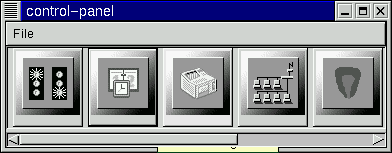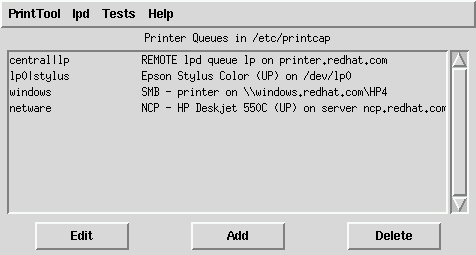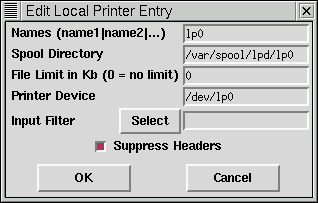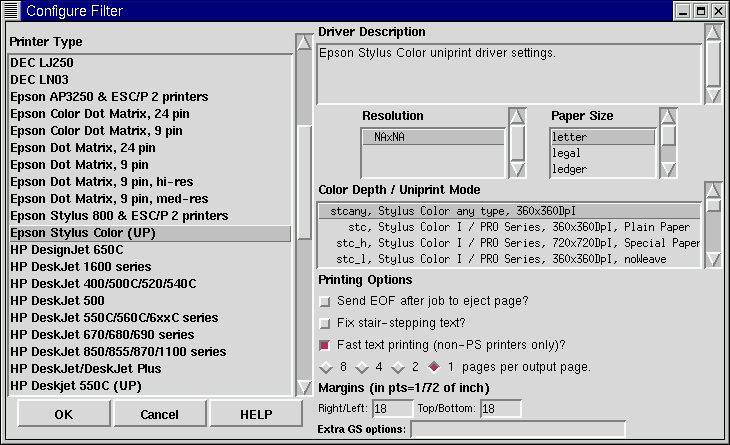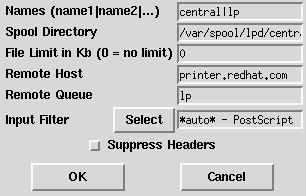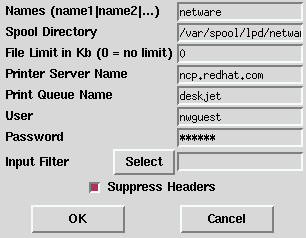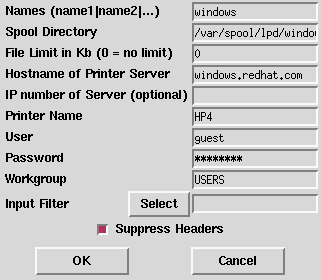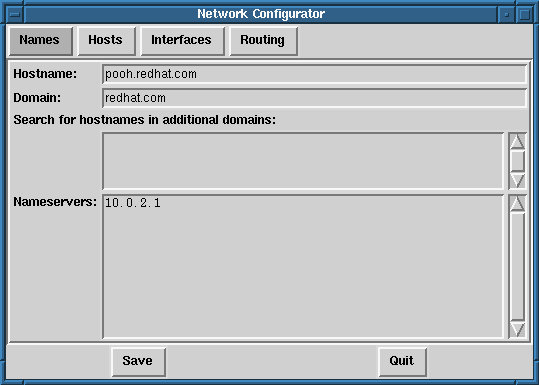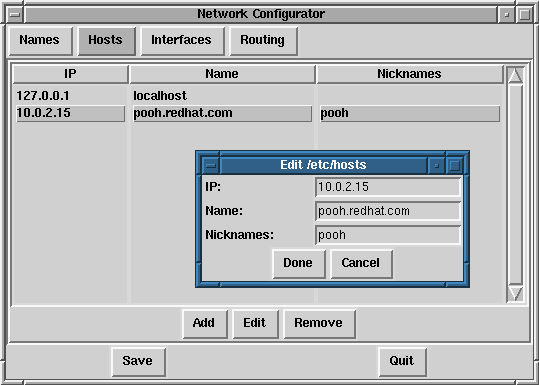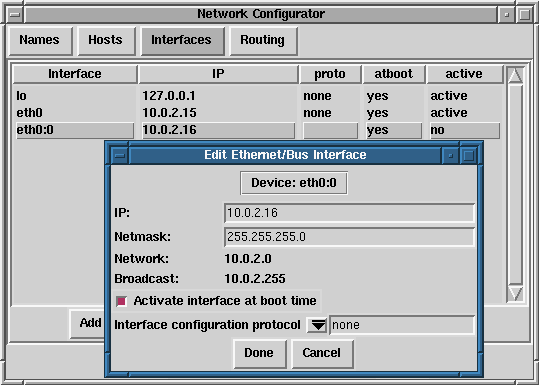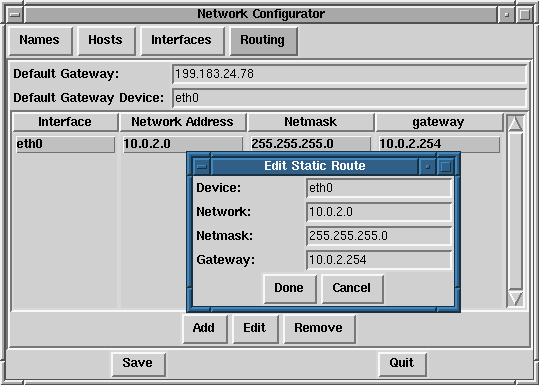System Configuration with the Control Panel
 | Please Note |
|---|---|
Most of what can be done with the control panel applications can also be done using linuxconf. In addition, linuxconf supports both character-cell and graphical user interfaces. Please refer to the section called System Configuration with linuxconf for an introduction to linuxconf. |
The control panel is a launching pad for a number of different system administration tools (see Figure 3-16). These tools make your life easier by letting you configure things without remembering configuration file formats and awkward command line options.
To start the control-panel, start the X Window System as root with startx and type control-panel in an Xterm. You will need to be root to run the control-panel tools successfully. You can do this as well if you already have X running as a normal user. Just type su -c control-panel and then type the root password when prompted. If you plan to do other tasks as root, you could type su followed by the root password when prompted.
 | Please Note |
|---|---|
If you are not running X as root, you may need to give root access to your system's X server. To do this, enter the following command on a non-root terminal window: |
xhost +localhost |
After starting the control panel, simply clicking on an icon starts up a tool. Please note that you are not prevented from starting two instances of any tool, but doing so is a very bad idea because you may try to edit the same files in two places and end up overwriting your own changes.
 | Please Note |
|---|---|
If you do accidentally start a second copy of a tool, you should quit it immediately. Also, do not manually edit any files managed by the control-panel tools while the tools are running. Similarly, do not run any other programs (such as linuxconf) that may change those files while the tools are running. |
Printer Configuration
Please note that the Official Red Hat Linux Getting Started Guide contains more up-to-date documentation on printtool, so be sure to check that document before using printtool.
The printer configuration tool (printtool) maintains the /etc/printcap file, print spool directories, and print filters. The filters allow you to print many different types of files, including:
plain text (ASCII) files
PostScript files
TeX .dvi files
GIF, JPEG, TIFF, and other graphics formats
RPMs
In other words, simply printing a GIF or RPM file using the lpr command will result in the printer doing "the right thing."
In order to create a new print queue, choose Add. Then, select what type of printer is being added. There are four types of print queues which can be configured with printtool:
Local print queues are for printers attached to a printer or serial port on your Red Hat Linux system
Remote print queues are attached to a different system which you can access over a TCP/IP network
SMB print queues are attached to a different system which uses LAN-Manager-type (SMB) networking
NCP print queues are attached to a different system which uses Novell's NetWare network technology
After choosing the printer type, a dialog box requests further information about the print queue (see Figure 3-19). All types of print queues require the following information:
Queue Name — What the queue will be called. Multiple names can be specifed with the | (pipe) character separating entries.
Spool Directory — This is the directory on the local machine where files are stored before printing occurs. Be careful to not have more than one printer queue use a given spool directory.
File Limit — Maximum size print job accepted, in kilobytes (1 kb = 1024 bytes). A size of 0 indicates no limit should be imposed.
Input Filter — Filters convert printed files into a format the printer can handle. Press Select to choose the filter which best matches your printer (see Figure 3-20).
In addition to configuring print queues able to print graphical and PostScript output, you can configure a text-only printer, which will only print plain ASCII text. Most printer drivers are also able to print ASCII text without converting it to PostScript first; simply choose Fast text printing when you configure the filter.

Please Note This only works for non-PostScript printers.
Suppress Headers — Check this if you don't want a header page printed at the beginning of each print job.
For local printers, the following information is also required:
Printer Device — Usually /dev/lp1; the name of the port which the printer is attached to. Serial printers are usually on /dev/ttyS? ports. Note that you will need to manually configure serial parameters.
For remote printers, the dialog box contains additional fields; fill in the following information:
Remote Host — Hostname of the remote machine hosting the printer.
Remote Queue — Name of the queue to print to on the remote machine.
The remote machine must be configured to allow the local machine to print on the desired queue. Typically /etc/hosts.lpd controls this.
For SMB and NCP printers, fill in the following information:
Hostname of Printer Server — Name of the machine to which the printer you want to use is attached.
IP number of Server — The IP address of the machine to which the printer you want to use is attached; this is optional and only relevant for SMB printers.
Printer Name — Name of the printer on which you want to print.
User — Name of user you must login as to access the printer (typically guest for Windows servers, or nobody for samba servers).
Password — Password (if required) to use the printer (typically blank). Someone should be able to tell you this if you do not already know it.
 | Please Note |
|---|---|
If you require a username and password for an SMB (LAN Manager) or NCP (NetWare) print queue, they are stored unencrypted in a local script. Thus, it is possible for another person to learn the username and password. It is therefore recommended that the username and password for use of the printer to be different than that for a user account on the local Red Hat Linux system, so that the only possible security compromise would be unauthorized use of the printer. If there are file shares from the SMB server, it is recommended that they also use a different password than the one for the print queue. |
After you have added your print queue, you may need to restart the printer daemon (lpd). To do so, choose Restart lpd from the lpd menu.
You may print a test page for any print queue you have configured. Select the type of test page you would like to print from the Tests menu.
Loading Kernel Modules
The Linux kernel has a modular design. At boot time, only a minimal resident kernel is loaded into memory. Thereafter, whenever a user requests a feature that is not present in the resident kernel, a kernel module is dynamically loaded into memory. After a specified period of inactivity, the module may be removed from memory. This design promotes leanness and efficiency.
The mechanism that supports dynamic loading of modules is a kernel thread called kmod. When the kernel requests a module, kmod wakes up and calls modprobe(8) to get it.
When you install Red Hat Linux, the hardware on your system is probed and you provide information about how the system will be typically used and which programs should be loaded. Based on this probing and the provided usage information, the installation program decides which features to compile into the resident kernel and which to put in loadable modules, and sets up the dynamic loading mechanism to work transparently. But this is a highly configurable procedure. If you build your own custom kernel, you can make all of these decisions for yourself.
If you add new hardware after installation requiring support provided in a kernel module, you need to set up the dynamic loading mechanism. You do this by editing the module configuration file, /etc/conf.modules.
For example, if at the time you installed Red Hat Linux your system included a model SMC EtherPower 10 PCI network adapter, the module configuration file will contain this line: alias eth0 tulip. If, after installation, you install a second identical network adapter to your system, add this line to /etc/conf.modules:alias eth1 tulip.
See Appendix A for an alphabetical list of kernel modules and the hardware the modules support.
Network Configuration
 | Please Note |
|---|---|
Documentation on network configuration using linuxconf can be found in the section called Getting Connected with Linuxconf (Network Configuration). |
The network configuration tool (netcfg) shown in Figure 3-25 is designed to allow easy manipulation of parameters such as IP address, gateway address, and network address, as well as name servers and /etc/hosts.
Network devices can be added, removed, configured, activated, deactivated and aliased. Ethernet, arcnet, token ring, pocket (ATP), SLIP, PLIP and loopback devices are supported. SLIP/PLIP support works well on most hardware, but some hardware setups may exhibit unpredictable behavior. When using the Network Configuration Tool click Save to write your changes to disk, to quit without making any changes select Quit.
Managing Names
The Names panel of the Network Configuration tool serves two primary purposes: setting the hostname and domain of the computer, and determining which name server will be used to look up other hosts on the network. The Network tool is not capable of configuring a machine as a nameserver. To edit a field or add information to a field, simply click on the field with the left mouse button and type the new information.
Managing Hosts
In the Hosts management panel you have the ability to add, edit, or remove hosts from the /etc/hosts file. Adding or editing an entry involves identical actions. An edit dialog box will appear, simply type the new information and click Done when you are finished. See Figure 3-26 for an example.
Adding a Networking Interface
If you have added a networking interface to your machine since installing Red Hat Linux, or you didn't configure your Ethernet card at install time, you can configure it with a few clicks of a mouse.
 | Please Note |
|---|---|
You may need to configure kerneld to load a driver for the network interface you are adding (e.g., eth0); see the section called Loading Kernel Modules for more information. |
Begin adding an interface by clicking on Interfaces in the main panel. This will bring up a window of configured devices with a row of available options, see Figure 3-27.
To add a device, first click the Add button then select the type of interface you want to configure from the box that appears.
 | Please Note |
|---|---|
There is now a clone button available in netcfg. This button can be used to create a "clone" of an already-existing interface. By using clone interfaces, it is possible for a laptop to have one Ethernet interface defined for a work LAN, and a clone Ethernet device defined for a home LAN. |
SLIP Interface
In order to configure a SLIP interface you must first supply a phone number, login name, and password. This will supply the initial parameters for the chat script needed to establish a SLIP connection. When you choose Done, a dialog titled Edit SLIP Interface appears that enables you to further customize the hardware, communication and networking parameters for your SLIP interface.
PLIP Interface
To add a PLIP interface to your system you only have to supply the IP address, the remote IP address, and the Netmask. You can also select if you want to activate the interface at boot time.
Ethernet, Arcnet, Token Ring and Pocket Adaptor Interfaces
If you are adding an Ethernet, arcnet, token ring or pocket adapter to your computer you will need to supply the following information:
Device — This is determined by netconfig based on the devices already configured.
IP Address — Enter an IP address for your network device.
Netmask — Enter the network mask for your network device.
The network and broadcast addresses are calculated automatically based on the IP address and netmask you enter.
Activate interface at boot time:
If you want the device to be configured automatically when your machine boots select this by clicking on the box.
Allow any user to (de)activate interface:
Check this if you want any user to be able to activate or deactivate the interface.
Interface configuration protocol:
If you have a BOOTP or DHCP server on your network and would like to use it to configure the interface, choose the appropriate option; otherwise, choose none.
After providing the configuration information for your new device, click Done. The device should appear in your Interfaces list as an inactive device. (The active column should have a label of no.) To activate the new device, first select it with a mouse click and then choose on the Activate button. If it does not come up properly, you may need to reconfigure it by choosing Edit.
Managing Routes
In the Routes management screen you have the ability to add, edit, or remove static networking routes. Adding or editing an entry involves identical actions, just like the Hosts panel. An edit dialog box will appear; simply type the new information and click Done when you are finished. See Figure 3-28 for an example.
Time and Date
The "time machine" allows you to change the time and date by clicking on the appropriate part of the time and date display and clicking on the arrows to change the value.
The system clock is not changed until you click on the Set System Clock button.
Click on Reset Time to set the time machine time back to that of the system.
 | Please Note |
|---|---|
Changing the time can seriously confuse programs that depend on the normal progression of time, and could possibly cause problems. Try to quit as many applications and processes as possible before changing the time or date. |
